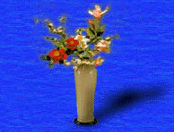
![]()


![]()

Ching Dynasty New Year Study Room Flower Arrangement
Theme: Good fortune with the coming of spring
Flowers: Camellia, pine, mei flower persimmon, lily, ling chi fungus
Vessels: Cobalt blue vase woth floral desogn in gold
Flwer style: Literati free style
The flowers, in order of prominence, are the camellias, mei flower
and pine sprigs. They form themselves into a triangular construction. This
composition is one of the most common styles of literati flower arrangements
since Ming and Ching Dynasties. However, this is a creation by a literati
arranged in seemingly casual order.
Decorations for this !study during the Ching Dynasty strove for such qualities as purity and simplicity. Flower compositions blended in natural harmony with other surrounding objects, making one of the smallest rooms in the household one of the most attractive and most livable.
![]()
Many of the flower arrangements during the Ching Dynasty consisted of only one vase and one type of flower, especially those found in study rooms and other places of quiet and repose. It was felt' that a single vase containing a single category of flower was better able to evoke the mood of silent contemplation required for such an environment than other combinations. There was no fixed place designated for such flowers. They might be found together with antiques, books, or against a backdrop of calligraphy. This contrasts with the practice of displaying flower compositions individually, more common during the Sung Dynasty.


![]()
[preface] [
styles] [religious]
[palace]
[literati]
[folk] [9 pricniples]
[significance] [preveration]
[vessels] [appreciatin]
[Pavilion of Taiwan, R.O.c] [Cultures] [Council For Cultural Affairs]